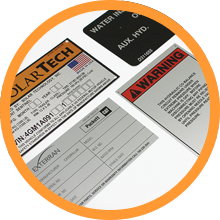A Definition of UL 969 Standards for Marking and Labeling
Sometimes referred to as ANSI 969, UL 969 is the standard for labels and markings. Items produced under this standard are pre-qualified and tested by Underwriters Laboratories (UL) for durability. Specifically, UL 969 is the standard for marking and labeling systems used for permanent product identification. Generally, these types of labels are nameplates that are applied to devices, appliances, and equipment that contain rating information, instructions, and schematics. The labels also may include safety-related information such as hazards, warnings, cautionary markings, electrical ratings, and installation instructions.

The requirements in UL 969 cover unprinted materials such as blank label stocks, overlaminations, laminating adhesives, and screen-printable adhesives that will become finished labels. They also cover specific combinations of label material, ink, and printing processes as well as labels that are intended to be mechanically attached or molded into a plastic part. According to the UL 969 Standards: “marking and labeling systems are evaluated for specific uses and for application to specific surface materials that are essentially smooth, flat, and rigid unless another surface configuration is specified by the manufacturer.”
Recent Updates to UL 969
The latest update to UL 969 was issued on May 30, 2017 and includes the addition of Hydraulic Fluid Immersion as an additional exposure condition. This addition pertains to the effects of certain hydraulic fluids, such as Skydrol (used in aircraft hydraulics/actuators), which have a solvent-like effect that can degrade and destroy certain label materials, such as plastic or painted metal labels. Specifically, UL 969 defines the hydraulic fluid immersion exposure condition as “Immersion for 48 ±0.5 h in hydraulic fluid that has a ISO Viscosity grade of 46.”
Manufacturers must choose labels capable of meeting these new specifications – materials able to withstand exposure to the hazards specified in UL 969. Metalphoto is one label material that holds up well to such conditions, exhibiting “no softening, staining, or noticeable fade after 24-hour exposure to: JP-4 fuel, Gasoline, Mineral spirits, Methyl ethyl ketone, Turpentine, Turbine & jet fuel, Kerosene, Xylol, Acetone, Toluol, Heptane, Trichlorethylene, MIL- H-5606 hydraulic fluid, and MIL-L-7808 jet engine oil.”
UL 969 Standard Certification Steps
When label manufacturers want to get their labels and markings certified, there are four general certification steps for them to follow:
- Send a prospective label to UL containing adhesive, substrate, ink, ribbon system, and/or lamination.
- Wait for UL to perform a series of tests including weathering and peel tests.
- UL certifies label constructions that meet the standard to various conditions including application surface such as wood, polycarbonate, powder-coated metal, temperatures from -20 to 150 degrees Celsius, and exposure such as occasional gasoline splash or indoor use only.
- Onsite UL inspectors then evaluate production of certified constructions annually and sends them to the lab for testing.
Label manufacturers should note that printers may not substitute materials or printing method once their labels are certified because it weakens the integrity of the certified label.
Categories within UL 969 Standards for Marking and Labeling
Marking and labeling systems are covered in one of five categories, which vary by type of product and end-use application. Labels and label materials that fall into the first four category code numbers (CCN) PGDQ2, PGJI2, PGIM2, and PGGU2 are tested using the test methods in UL 969 Marking & Labeling Systems and are appropriate for use on a broad range of UL-Certified products. Because labels in the category code PGIS2 are considered limited use, they are evaluated using unique label requirements for specific UL-certified products.
The categories are as follows:
- Marking & Labeling Systems – CCN (Certified to UL Requirements): PGDQ2
- PGDQ2 is the highest level UL certification for labels, requiring that manufacturers get the adhesive, base material, printing, system, and lamination approved as a complete system. This standard typically applies to warning, danger, and caution labels that must remain legible for the product’s lifecycle.
- PGDQ2 is the highest level UL certification for labels, requiring that manufacturers get the adhesive, base material, printing, system, and lamination approved as a complete system. This standard typically applies to warning, danger, and caution labels that must remain legible for the product’s lifecycle.
- Marking & Labeling Systems, Printing Materials – CCN (Certified to UL Requirements): PGJI2
- PGJI2 is the UL certification level for blank labels printed on thermal printers. Typically, these labels are printed by the OEM in their facility at the time of manufacture. At this certification level, the label material and the thermal ribbon must be tested for compatibility as a complete system.
- Marking & Labeling Systems, In-Mold – CCN (Certified to UL Requirements): PGIM2
- PGIM2 is the UL certification that covers finished printed labels that are bonded to plastic surfaces during plastic-molding processes. The in-mold labels are appropriate for the molding process, generic plastic surface, and environmental use conditions and are intended to provide warnings, instructions, or other information that should be permanently marked on products.
- Marking & Labeling Systems, Materials – CCN (Certified to UL Requirements): PGGU2
- PGGU2 is a certification that requires only the UL certification on the material. Label suppliers do not need to do any additional testing to their labels. Typically, labels in the PGGU2 certification are informational in nature and are not warning, caution, or danger labels.
- Marking & Labeling Systems, Limited Use – CCN (Certified to UL Requirements): PGIS2
- PGIS2 covers cord tags and placards that are evaluated for complying with requirements in specific UL end-product standards when the performance requirements are less stringent or differ from those in the UL 969 Marking and Labeling Systems. Labels falling into the PGIS2 category typically are products like enclosures for electrical equipment, power supply cords, and gate operators.
Images via Flickr by jblevine2004 and Beige Alert


